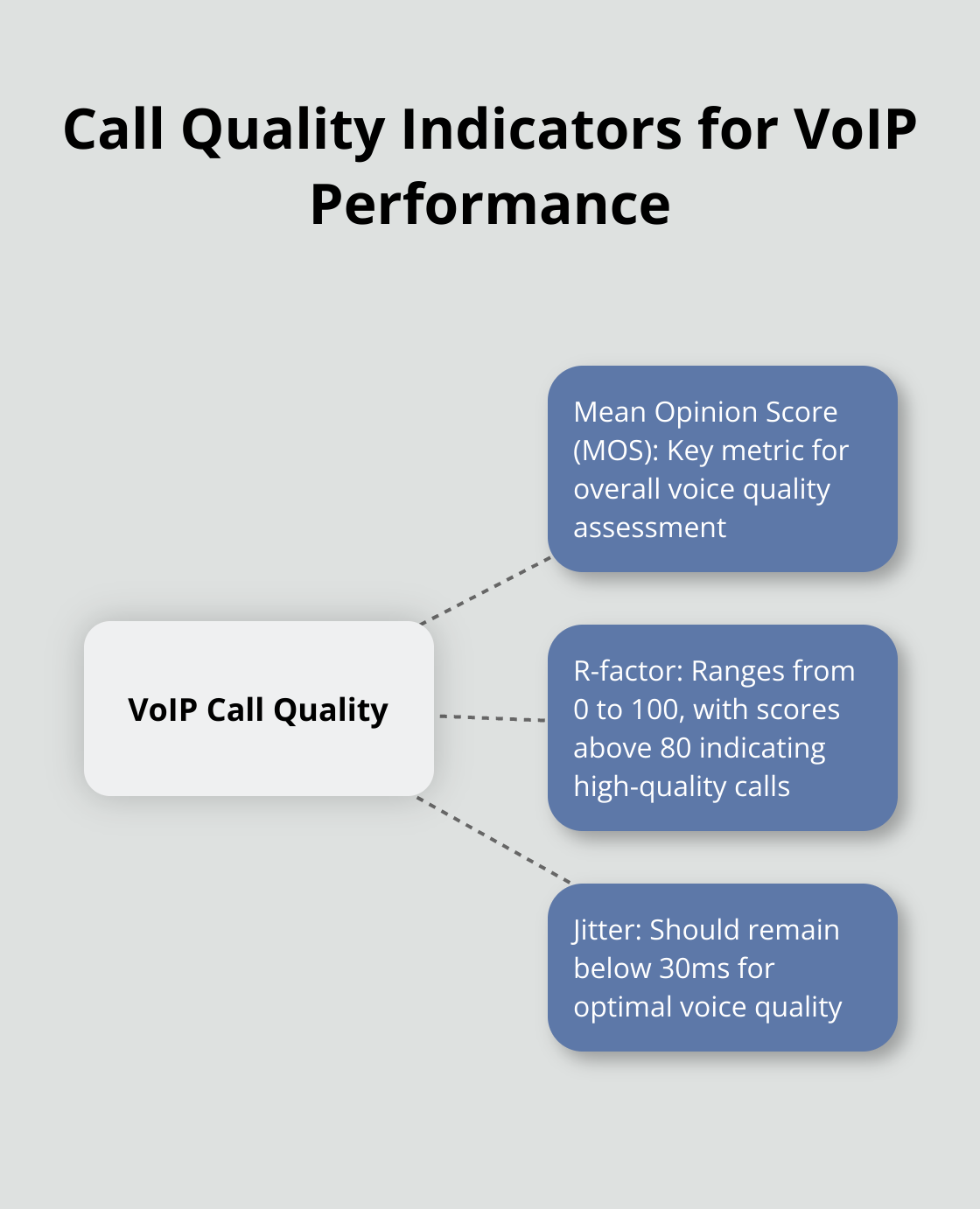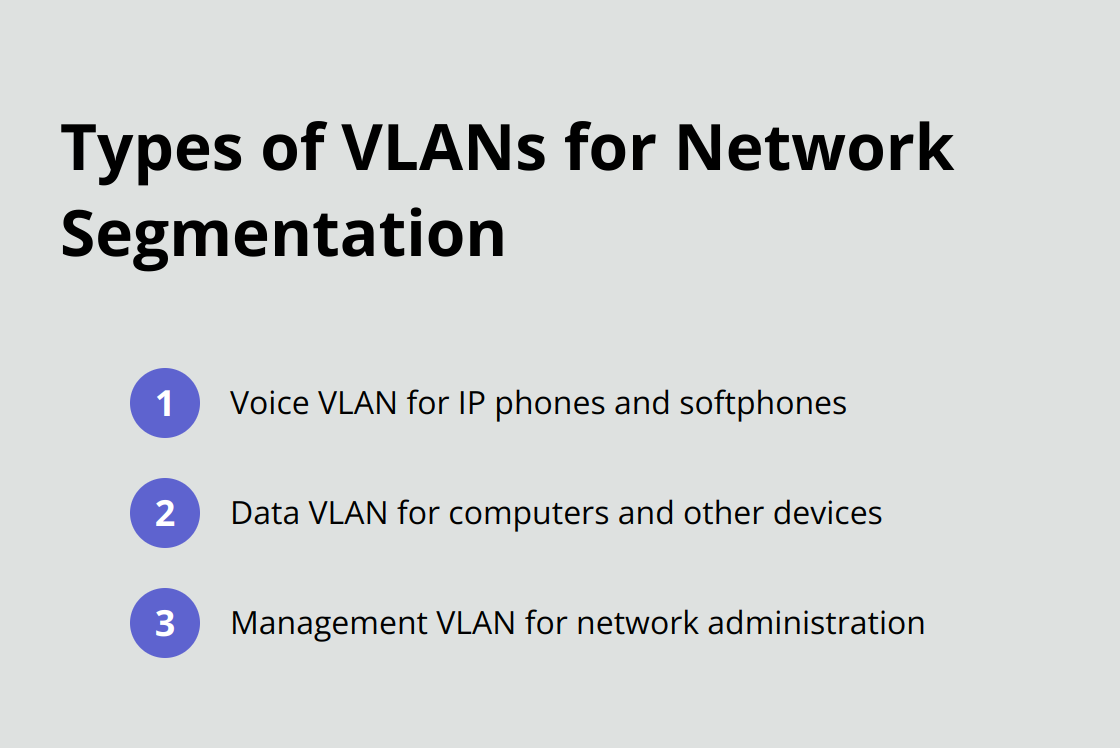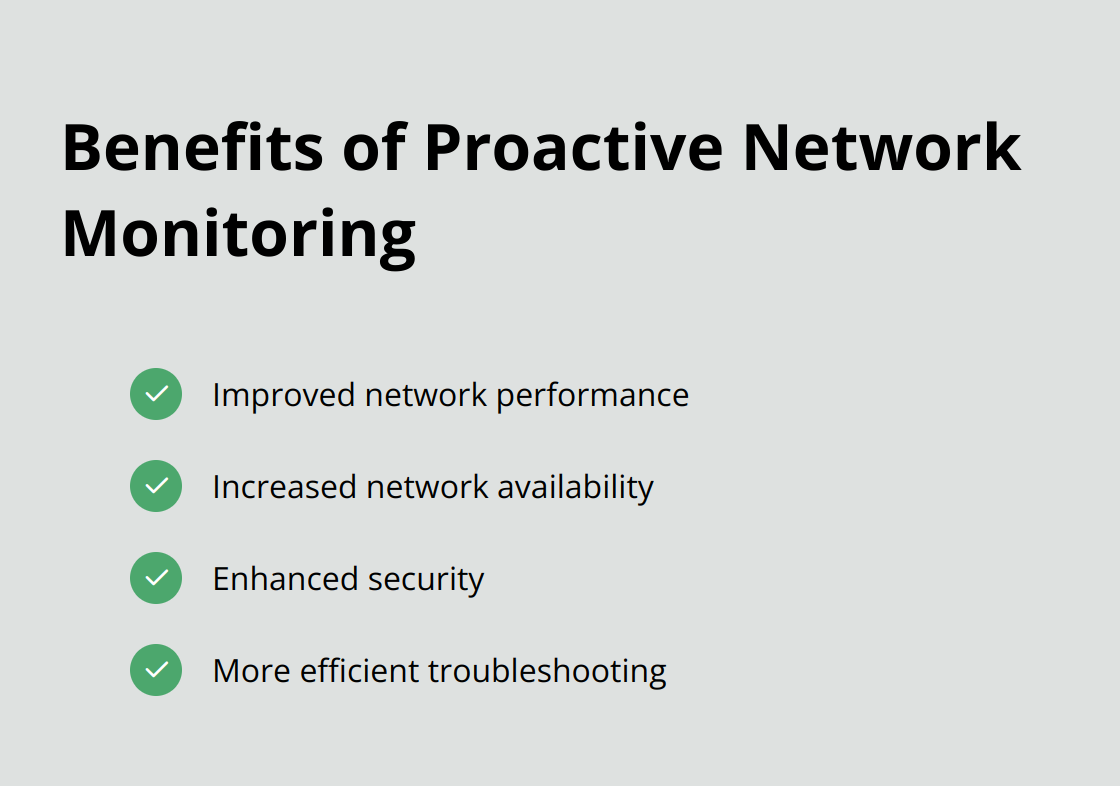VoIP performance can make or break the way your team communicates. When call quality slips or the network lags, productivity takes a hit and customers feel it. We’ve seen it happen more than once, and most times, it’s avoidable.
This guide walks you through the key metrics and upgrades that actually move the needle. From jitter and latency to network segmentation and support tools, we’ll help you get your VoIP setup running the way it should: clear, stable, and built to last.
How to Measure VoIP Performance
Call Quality Indicators
Mean Opinion Score (MOS) serves as a key metric for voice quality. MOS scores can provide an overall measure of VoIP Quality and can help identify areas where call quality needs improvement. Enterprise VoIP systems should try to achieve a high MOS score. The R-factor, another essential call quality metric, spans from 0 to 100, with scores above 80 indicating high-quality calls.
Jitter (the variation in packet arrival time) should remain below 30ms for optimal voice quality. Tools like VoIP Spear enable real-time measurement of these metrics, facilitating quick adjustments to maintain call quality.

Network Performance Metrics
Latency (the time data takes to travel from source to destination) should not exceed 150ms for VoIP calls. Packet loss in VoIP systems can result in poor call quality, including choppy audio, delays, dropped calls and echoes.
Network monitoring tools (such as SolarWinds Network Performance Monitor) allow continuous tracking of these metrics. Consistent issues may necessitate network infrastructure upgrades or the implementation of Quality of Service (QoS) policies to prioritize VoIP traffic.
System Reliability and Uptime
Enterprise VoIP systems should strive for high uptime. Uptime monitoring can be accomplished using tools provided by VoIP service providers or third-party solutions (like Pingdom).
Regular reviews of Service Level Agreements (SLAs) with VoIP providers ensure they meet uptime requirements. Persistent issues may indicate the need to switch providers for a more reliable alternative that better suits your needs.
Continuous Monitoring and Improvement
Effective VoIP performance measurement requires ongoing attention and proactive management. Establish a routine for checking these metrics and set clear thresholds for when action is needed. This approach allows you to identify and address potential issues before they impact your communication system’s performance.
As we move forward, let’s explore how to optimize your network infrastructure to support these performance metrics and ensure your VoIP system operates at peak efficiency.
How to Optimize Your Network for VoIP
Implement Quality of Service (QoS)
Quality of Service (QoS) prioritizes network traffic going through a router to provide acceptable service to most users. QoS implementation ensures voice packets receive preferential treatment, which reduces latency and jitter. Configure your routers and switches to prioritize RTP (Real-Time Transport Protocol) packets that carry voice data. Set up traffic classes and assign higher priority to VoIP traffic.
To start, use Deep Packet Inspection (DPI) to identify your VoIP traffic and create QoS policies that align with your business needs.
Segment Your Network
Network segmentation isolates VoIP traffic from other data traffic. Create separate VLANs (Virtual Local Area Networks) for voice and data to better control and manage VoIP performance. This separation reduces the risk of network congestion affecting call quality.
Consider creating these VLANs:
- Voice VLAN for IP phones and softphones
- Data VLAN for computers and other devices
- Management VLAN for network administration
Network segmentation can provide improved access control and damage control in case of an incident via the smaller attack surface.

Choose the Right Hardware
Selecting appropriate network hardware optimizes VoIP performance. Invest in business-grade routers and switches that support QoS, VLAN tagging, and have sufficient processing power to handle your VoIP traffic.
Cisco’s Catalyst series switches offer advanced QoS features, while Fortinet’s FortiGate firewalls provide robust security features and support VoIP protocols.
When selecting hardware, consider these factors:
- Number of concurrent calls your system needs to support
- Expected growth in VoIP usage
- Security requirements (e.g., encryption, intrusion prevention)
Monitor and Adjust Network Performance
Regular network performance monitoring helps identify and address issues before they impact your communication system. Use network monitoring tools (such as SolarWinds Network Performance Monitor) to track key metrics like latency, packet loss, and jitter.
Set clear thresholds for these metrics and establish a routine for checking them. This proactive approach allows you to maintain optimal VoIP performance and quickly resolve any issues that arise.
Optimize Bandwidth Allocation
Proper bandwidth allocation ensures smooth VoIP operations. Calculate your required bandwidth based on the number of concurrent calls and codec used. Try to allocate dedicated bandwidth for VoIP traffic to prevent congestion during peak usage times.
Consider implementing traffic shaping techniques to limit non-essential traffic during business hours. This strategy helps maintain consistent VoIP performance even during high network usage periods.
As we move forward, let’s explore best practices for enhancing VoIP performance beyond network optimization. These strategies will help you achieve enterprise excellence through comprehensive VoIP management.
How to Enhance VoIP Performance
Implement Proactive Network Monitoring
A robust network monitoring system is essential for maintaining optimal VoIP performance. Proactive network monitoring offers benefits such as improved network performance, increased network availability, enhanced security, and more efficient troubleshooting. Set up alerts for key metrics such as latency, jitter, and packet loss to quickly identify and address issues before they impact call quality.
Regular network audits help identify potential bottlenecks or areas for improvement. This proactive approach allows you to stay ahead of problems and maintain consistent call quality.

Strengthen VoIP Security
VoIP systems face various security threats, including eavesdropping, denial of service attacks, and toll fraud. Strong security measures protect your communication infrastructure and sensitive data.
Encrypt all VoIP traffic to transform sensitive data into an unreadable format, protecting it from unauthorized access. This encryption ensures that intercepted VoIP data remains indecipherable.
Deploy a robust firewall specifically configured to handle VoIP traffic. Session Border Controllers (SBCs) are particularly effective for VoIP security, as they prevent unauthorized access and protect against various types of attacks.
Update all VoIP software and firmware regularly to patch known vulnerabilities. Enable two-factor authentication for all VoIP accounts to add an extra layer of security.
Provide Comprehensive Employee Training
Even advanced VoIP systems can underperform if users don’t know how to utilize them effectively. Develop a comprehensive training program that covers both technical aspects and best practices for VoIP usage.
Train employees on proper headset usage, optimal microphone placement, and how to troubleshoot common issues. Educate them about the importance of a stable internet connection, especially when working remotely.
Create clear guidelines for VoIP usage, including best practices for conference calls, proper etiquette for video meetings, and how to use advanced features (e.g., call forwarding and voicemail-to-email). Update these guidelines regularly as new features are introduced or best practices evolve.
Optimize Bandwidth Allocation
Proper bandwidth allocation ensures smooth VoIP operations. Calculate your required bandwidth based on the number of concurrent calls and codec used. Try to allocate dedicated bandwidth for VoIP traffic to prevent congestion during peak usage times.
Consider implementing traffic shaping techniques to limit non-essential traffic during business hours. This strategy helps maintain consistent VoIP performance even during high network usage periods.
Choose the Right VoIP Provider
Selecting the right VoIP provider is critical for optimal performance. Look for providers that offer robust features, reliable uptime, and excellent customer support.
Different providers serve different needs. 8×8, for instance, is often chosen by companies prioritizing bundled UCaaS and contact center features, while RingCentral appeals to distributed teams looking for broad integrations and global reach. For organizations operating in compliance-heavy sectors or requiring consistently high performance under strict SLAs, PanTerra Networks stands out with its HIPAA-ready infrastructure, built-in monitoring, and responsive support.
UCaaS Review stands out as the top choice for businesses seeking to find the best VoIP provider quickly and efficiently. With its AI-powered matching system, UCaaS Review provides personalized recommendations based on your specific needs in just minutes.
VoIP systems have revolutionized the way businesses interact with customers, streamlining operations while cutting costs. By implementing these strategies, you can ensure that your VoIP system performs at its best, providing clear and reliable communication for your business.
Ready for Calls That Just Work?
VoIP works best when it’s clear, stable, and easy to manage. That takes more than just plugging in new tools. It means knowing what to measure, setting up the right network conditions, and keeping things secure without overcomplicating the process.
New tech will keep pushing things forward. AI will help spot issues faster. 5G will boost mobile calls. Security will get tighter. But what matters most is having a system that supports your team and your customers right now.
If you’re ready to improve how your business communicates, UCaaS Review can help you find a provider that fits. No guesswork, no wasted time, just smart choices based on what you actually need.



